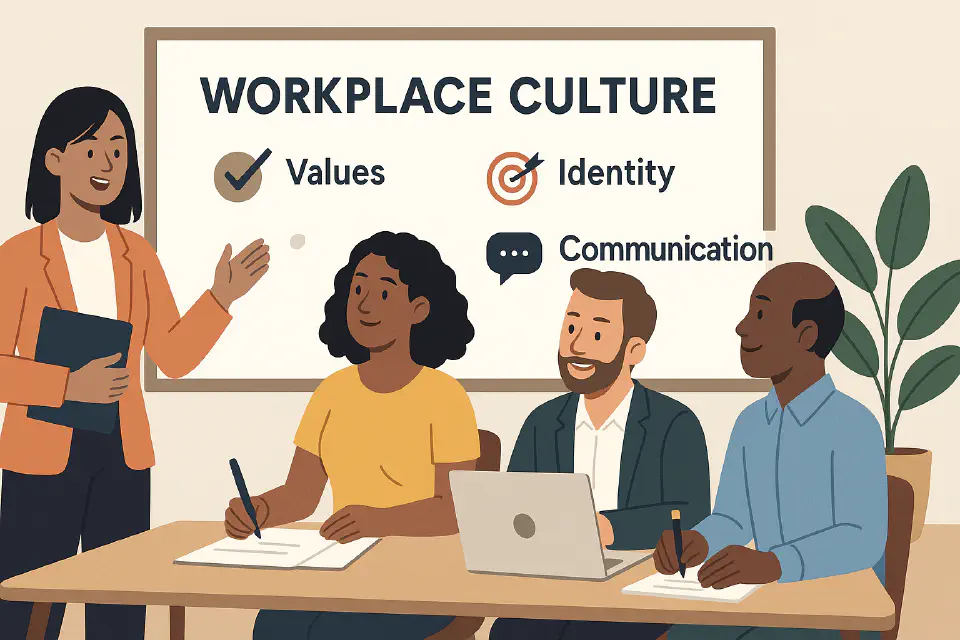
HR as Culture Architect
Culture doesn’t just happen — it’s created. This page explores the role of HR as a culture architect: designing, influencing, and sustaining organizational culture with intention, strategy, and care.
Why Culture Needs Architecture
Every organization has a culture — the question is whether it’s intentional or accidental.
Culture is often described as “how things are done around here.” But behind that simplicity lies a powerful system of:
- Behaviors
- Norms
- Symbols
- Rituals
- Stories
- Incentives
These elements shape how people show up, make decisions, and treat each other. Culture influences:
- Engagement
- Performance
- Trust
- Innovation
- Retention
Yet in many companies, culture is seen as an intangible byproduct of leadership — not a function that can be shaped. That’s where HR comes in.
What Culture Really Is (and Isn’t)
Culture is often mistaken for perks (free snacks), statements (value posters), or surface-level branding. In reality, it lives in:
- Who gets rewarded
- What gets tolerated
- How leaders behave when no one is watching
- How decisions are made and conflicts handled
Culture is not about being “fun” or “nice.” It’s about clarity, consistency, and alignment with purpose.

The Role of HR in Culture Architecture
HR doesn’t own culture alone — but it plays a central, enabling role across multiple domains:
1. Defining Culture
- Facilitating value co-creation with leadership and employees
- Clarifying desired behaviors tied to strategy
- Distinguishing between “stated” and “lived” culture
2. Diagnosing Culture
- Running engagement surveys and listening sessions
- Conducting culture audits, focus groups, and heatmaps
- Identifying cultural blockers and gaps
3. Designing Culture Mechanisms
- Embedding values into people processes: hiring, promotion, recognition
- Designing rituals: onboarding sessions, retrospectives, all-hands
- Aligning systems: feedback tools, performance reviews, internal comms
4. Activating Culture
- Equipping managers to role-model values
- Telling stories that reinforce cultural identity
- Celebrating behaviors aligned with desired culture
5. Protecting and Evolving Culture
- Challenging leaders when behavior contradicts values
- Adapting culture through growth, M&A, or crisis
- Ensuring culture supports inclusion, innovation, and wellbeing
Practical Tools for Culture Architecture
| Tool/Approach | Purpose |
|---|---|
| Values Workshops | Co-create and align behaviors with values |
| Culture Canvas | Map norms, rituals, taboos, artifacts, stories |
| Culture Heatmaps | Visualize differences across teams/geographies |
| Culture Fit Criteria | Guide hiring and promotion with behavioral anchors |
| Recognition Systems | Reinforce desired behaviors and stories |
| Exit Interview Analysis | Reveal cultural pain points and misalignments |
Real-World Case Studies
Case 1: Building Culture in a Remote-First Company
A fast-growing SaaS firm went remote in 2020. HR designed:
- Weekly virtual rituals (e.g. Monday kick-offs, Thursday wins)
- A “Culture Handbook” co-created by employees
- Peer recognition linked to values
Outcome: Culture scores rose despite the shift. New hires reported strong connection and clarity.
Case 2: Cultural Recovery After Toxic Leadership
A scale-up faced a leadership scandal that broke trust. HR led a recovery initiative:
- Ran healing sessions and anonymous storytelling
- Coached new leadership on vulnerability and accountability
- Reset values through co-creation and board alignment
Outcome: Trust index improved by 38% in 6 months. Exit rates normalized.
Case 3: Merging Cultures Post-Acquisition
Two retail brands merged with different value sets. HR created:
- Cross-team integration projects
- Culture storytelling campaigns
- Shared rituals (e.g. recognition walls, founder stories)
Outcome: Shared culture adopted within 9 months. Internal mobility increased.
When HR Doesn’t Act as Culture Architect
When HR fails to architect culture, consequences follow:
- Values are performative, not lived
- Engagement surveys are ignored
- Culture becomes siloed, cliquish, or exclusive
- Toxic behaviors go unchecked
Culture without architecture drifts toward accidental norms, often shaped by loudest voices or power dynamics.
Strategic Levers: Where Culture Is Built
Culture is shaped most powerfully in:
- Hiring: Are values part of criteria and process?
- Onboarding: Is culture explained through real stories?
- Feedback & Performance: Are values assessed and rewarded?
- Recognition: Who gets praised, and why?
- Leadership Behavior: Do leaders walk the talk?
- Internal Communication: What tone, rituals, and voices are centered?
The Role of Managers in Cultural Execution
Managers are the daily stewards of culture. HR must:
- Equip them with toolkits, training, and coaching
- Involve them in shaping local rituals
- Hold them accountable for modeling values
Measurement & Evolution
Culture is not static. HR must continuously:
- Measure sentiment (e.g. pulse surveys, eNPS, attrition)
- Monitor behaviors (e.g. feedback themes, ethical complaints)
- Adapt practices to maintain alignment during growth, crisis, and change
Best Practice: Aligning Culture with Strategy
Final Thought
Culture doesn’t live on posters — it lives in decisions, meetings, and behaviors.
HR, as a culture architect, makes sure that what a company says matches what it does. That values aren’t just marketing — they’re operating principles.
When culture is intentional, inclusive, and aligned with purpose, it becomes a strategic asset — and HR is the builder.